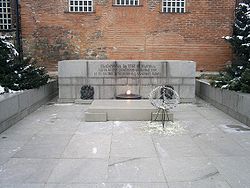- Monument to the Unknown Soldier, Sofia
-
Monument to the Unknown Soldier
Паметник на Незнайния воинBulgaria 
Monument to the Unknown SoldierFor the Battle of Stara Zagora and the Battle of Shipka Pass heroes Unveiled 22 September 1981 Location near Sofia Coordinates: 42°41′46.8″N 23°19′53.27″E / 42.696333°N 23.3314639°E The Monument to the Unknown Soldier (Bulgarian: Паметник на Незнайния воин, Pametnik na Neznayniya voin) is a monument in the centre of Sofia, the capital of Bulgaria, located just next to the 6th-century Church of St Sophia, on 2 Paris Street. The monument commemorates the hundreds of thousands of Bulgarian soldiers who died in wars defending their homeland. Ceremonies involving the President of Bulgaria and foreign state leaders are often performed here. The monument was designed by architect Nikola Nikolov and opened on 22 September 1981.
The Monument to the Unknown Soldier features an eternal flame, turf from Stara Zagora and Shipka Pass, sites of two of the most important battles of the Russo-Turkish War of Liberation (the Battle of Stara Zagora and the Battle of Shipka Pass), a sculpture of a lion (a national symbol of Bulgaria) by the noted sculptor Andrey Nikolov, as well as a stone inscription of a stanza (part of The New Graveyard Above Slivnitsa 1885 poem) by the national writer Ivan Vazov:
“ БЪЛГАРИЙО, ЗА ТЕБЕ ТЕ УМРЯХА,
ЕДНА БЕ ТИ ДОСТОЙНА ЗАРАД ТЯХ
И ТЕ ЗА ТЕБ ДОСТОЙНИ, МАЙКО, БЯХА!” “ O BULGARIA, FOR YOU THEY DIED,
ONLY ONE WERE YOU WORTHY OF THEM
AND THEY OF YOU WORTHY, O MOTHER, WERE!” After end of the First World War, a group of Bulgarians proposed building the monument. However, strong opposition to the building of this monument arose. Some Bulgarian intellectuals argued that a monument of an unknown soldier is unacceptable since it would imply that the names of the soldiers have been forgotten. "Not a single soldier shall be forgotten who gave his life in this war and in all other wars for the freedom of Bulgaria!".
The monument was designed but was not displayed because of the above mentioned arguments. The lion itself was considered an abuse for a long time because it was sitting. The pose was considered a metaphor of surrender to the national ideas. For more than fifty years the statue and the idea of the monument stayed frozen until finally it was officially opened in 1981 for the 1300 years' celebration of the founding of Danube Bulgaria.
Categories:- Buildings and structures in Sofia
- Monuments and memorials in Bulgaria
- Visitor attractions in Sofia
- 1981 works
- Military memorials and cemeteries
- Bulgarian building and structure stubs
Wikimedia Foundation. 2010.

